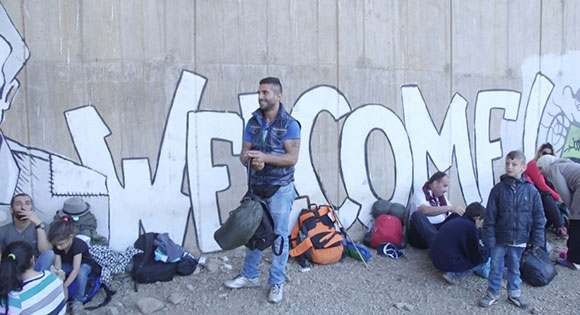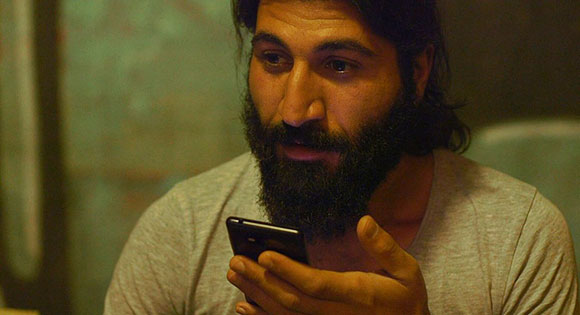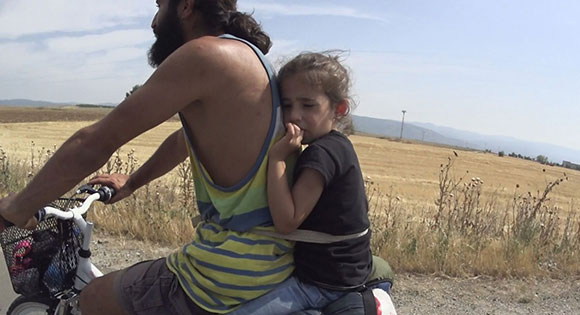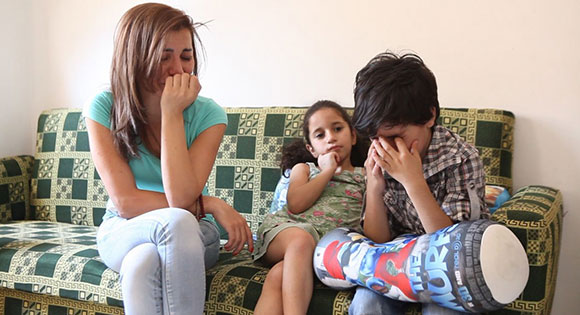The Journey can be found on the New Yorker website where it debuted in May for a 90 day exclusive run. Watch it here.
Syria's horrendous civil war has nearly destroyed the country with bombs decimating cities. An estimated 220,000 people have died, half of whom are believed to be civilians. Human rights violations are rampant. Basic necessities such as food and medical care are sparse.
Thousands of Syrians escape their homeland every day after witnessing the destruction of their neighborhoods and the deaths of family members and friends. The majority of Syrian refugees are living in Jordan and Lebanon — the two smallest countries in the region. The weak infrastructure and limited resources are putting an immense strain on these two nations. Some Syrian refugees have escaped into northern Iraq but are now trapped by that country's own conflicts and turmoil; more than one million Iraqis are displaced as well. Others have gone to Turkey.
The U.N. predicts that there could be 4.7 million registered Syrian refugees by the end of 2016 — the worst exodus since the Rwandan genocide 20 years ago.
Shining a Light on the Syrian Refugee Crisis
Field of Vision and The New Yorker have created a six-part episodic documentary, filmed in 2015, that immerses us in the Syrian refugee crisis. Matthew Cassel, an independent multimedia journalist and filmmaker based in Istanbul, follows the seven-month, obstacle-laden 1700-mile journey of Aboud Shalhoub, a Syrian refugee who has fled the dangers of wartime Damascus in order to build a better life for his family in the Netherlands. Cassel's colleague Simon Safieh remained in Damascus with Aboud's wife and two children, who eventually join him in Europe.
A Documentary for the Social Media Generations
Cassel, Laura Poitras (Citizen Four; My Country, My Country; The Oath), and AJ Schnack have created a six-part documentary where each segment runs about ten minutes or so. This brevity and conciseness is tailor-made for people who have short attention spans. The film gives busy viewers a chance to exercise their empathy by putting themselves in the shoes of this family as they risk all in a journey which they hope will result in new life and personal transformation.

The brevity of each segment also gives us a chance to reflect upon the refugee experience. We found ourselves taking a break after each episode and talking about what we had seen and where we could empathize with the refugees. We talked about these realities:
- For refugees, familiar places and faces are only memories.
- A heavy curtain has been pulled over the future. They do not know what is behind it.
- Their leaving home may bring relief but there is also a deep sense of loss, as they realize how much they have been forced to leave behind.
- Their journey takes them across borders, and they must constantly adapt and improvise in these new territories.
- Letting go of the past is hard, and we know that the more we cling to it, the more we suffer. But homesickness is something different. It is a genuine emotion that stands as an affirmation of our respect for place.
- There is so much pleasure in reunions with loved ones. Only tears of joy can express the meanings and the magnificence of these encounters.
Synopsis of The Journey
1. Part One
For two years, Aboud Shalhoub, a Syrian jeweler, has been working in Istanbul, Turkey. He decides to travel to Europe as a refugee and apply for asylum in the Netherlands. If this plan works, he will bring his wife Christine and two children from Damascus to his new homeland. The only connection he has with them now is through Skype calls.
Aboud and his brother Amer go to Edirne, a Turkish town on the border with Greece. The two brothers cross the Aegean sea in a small dinghy jammed with refugees. The conditions aboard the vessel are terrible, and they have to be rescued by a larger ship.

2. Part Two
After arriving in Athens, Shalhoub visits the Acropolis in the center of the city, where he ponders the meaning of freedom. The two brothers take note of their choices and decide to walk to the Macedonian border.
3. Part Three
About a hundred refugees continue on together in order to protect themselves from police and thieves; they come from Syria, Iraq, Yemen, and Afghanistan. The two brothers act as surrogate uncles to the two young daughters of a Syrian single mother named Fadwa.

4. Part Four
The brothers make the best of cycling to Serbia, the last country they must traverse before arriving in the European Union. At the next stop Aboud intends to apply for family reunification. Meanwhile, Christine's mother in Damascus warns her not to make Europe into a paradise in her mind.
5. Part Five
After hiking down railroad tracks and winding their way through farmer's fields in the Balkans, the two brothers bid farewell to the two little girls and their mother, who head off to Sweden. Aboud notifies Christine that they have been accepted for asylum in the Netherlands. Christine looks forward to seeing her husband for the first time in three years, but there are tears and deep emotions at her farewell party with family and friends.

6. Part Six
Aboud and his family study Dutch, and he finds work making molds for concrete blocks. As they try to adjust to their new life, they are taken aback by the anti-immigrant sentiment afoot in their new country. He is convinced that his experiences have given him a unique perspective on the refugee crisis in the Netherlands.
